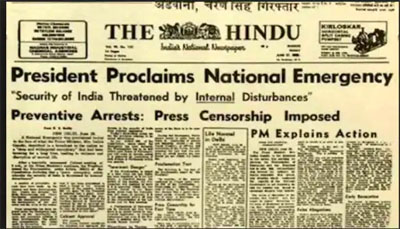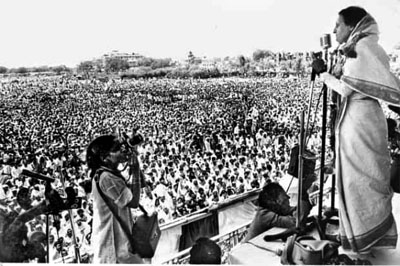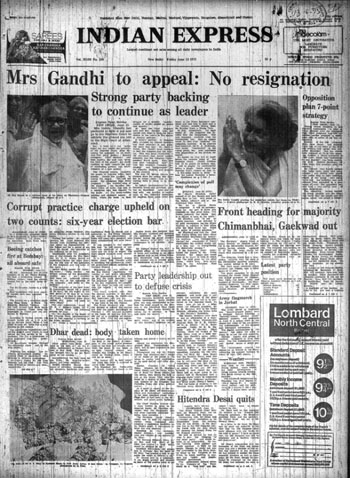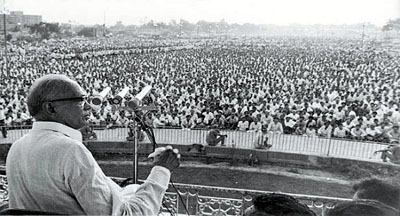|
Emergency in India, Faux and Real
Vinay Lal

On the night of June 25-26, forty-five years ago, President Fakhruddin Ali Ahmed, acting at the behest of Prime Minister Mrs. Indira Gandhi, imposed an emergency in India and suspended all civil liberties. Speaking to the country on the morning of the 26th from the studios of All India Radio, Mrs. Gandhi stated that the emergency had been necessitated by “the deep and widespread conspiracy which has been brewing ever since I began to introduce certain progressive measures of benefit to the common man and woman of India.” She warned that “forces of disintegration” and “communal passions” threatened to tear apart India and that she was impelled to act from the desire to preserve the country’s unity. “There is nothing to panic about”, she advised her fellow Indians, and, as if to assure them that the drastic step that had been taken to put the Constitution of India into abeyance was not being done to advance her own interests, she insisted that “this is not a personal matter” and that it “is not important whether I remain Prime Minister or not.”

Mrs. Gandhi holds an election rally at Ramlila Grounds in Delhi, February 1977. Source: Indian Express.
Far more so than the democratic leader of a state, the despotic ruler likes to believe that he (or she, as in this case) only acts in the interest of the people. Two weeks earlier, acting on a petition filed by Mrs. Gandhi’s political opponent, Raj Narain, a judge of the Allahabad High Court delivered a judgment which unseated Mrs. Gandhi. Justice Jagmohanlal Sinha declared her election to Parliament “null and void” on the grounds that she had engaged in corrupt election practices. Mrs. Gandhi stood convicted of two charges: the state government of Uttar Pradesh, which was very much in the hands of the Congress Party, had apparently built a stage which allowed her to address election meetings “from a dominating position”; and, secondly, that her election agent was in government service and was therefore barred from any political activity. That Mrs. Gandhi’s election could be set aside on what today would be deemed entirely frivolous charges, if they were noticed at all, is a testament not so much to the honesty and innocence of those days but rather to the steep decline in morals in public and political life.

Justice Sinha gave Mrs. Gandhi leave to file an appeal to the Supreme Court within twenty days, and the Supreme Court convened for the first hearing on the 23rd; but before the Court could deliver its judgment, Mrs. Gandhi had already acted. Her fall might have seemed inconceivable to many observers, considering that she was hailed for leading India to a decisive military victory over Pakistan in December 1971 and orchestrating the dismemberment of India’s arch enemy. In May 1974, in an operation termed “Smiling Buddha”, India carried out a “peaceful nuclear explosion”—we shall pass without comment in the interest of brevity the politics of this twisted expression—and Mrs. Gandhi thereby signaled to the world India’s intention to become the hegemon in South Asia.
Nevertheless, in spite of Mrs. Gandhi’s popularity, India was restless. Almost thirty years into independence, the country remained desperately poor; the literacy rate for women in some districts was in the single digits. Growth had been agonizingly slow, yet the population continued to swell. Some economists jibed at the country’s “Hindu rate of growth”: the annual growth rate of the economy appeared to run in tandem with the birth rate. Milk, butter, sugar, cooking oil, and other essential items remained in short supply. It was not uncommon even for middle-class people, let alone the poor, to have to wait in long lines for rations. Far too many people were beginning to ask: is this the freedom for which we dreamed and waged an anti-colonial struggle?
Though the Congress under Mohandas Gandhi, Nehru, and others had shepherded the country to freedom, allegiance to the party was beginning to wear off. Opposition to the Congress had been fragmented, but by early 1974 the Gandhian socialist leader, Jayaprakash Narain, known to everyone as JP, was able to bring together students, peasants, workers, and intellectuals under the slogan of “Total Revolution”. A nationwide strike led by the union representing the employees of Indian Railways, the largest employer in the country, was doubtless interpreted by Mrs. Gandhi as an ominous sign of difficult days ahead for her.

Jayaprakash Narain, known to the people as JP, addresses a rally
What Mrs. Gandhi called an “emergency”, which would last until March 1977, was a deadly stab at democracy in action. And democracy is a frightening prospect to despots, however they may be clothed. It was a fake emergency, nothing more than an odious attempt at rule by one person. The odd thing is that today, forty-five years later, India is doubtless facing a real and undeclared emergency that dwarfs the social, economic, and political problems that India faced at that time. The country has been brought to a condition of utter ruination by the ruling party and the middle-class elites that have sought to profit in every respect from their willing acquiescence to an economic and political program, now six years in the making, that rests on nothing else but power and personal gain.
It does the government no good to impute that its present problems are on account of the coronavirus pandemic. Early last year, the country’s unemployment rate was the highest since 1974, and readers will recall that the government made every attempt to stop the publication of the data before the election. The government need not have feared, as the election results showed. Manufacturing has been in a slump for the last three years. Car sales, a measure that the government uses to point to the growth of the middle class, were down by 35% at the end of 2018. 80 percent of the population, according to all available indices, still lives on the equivalent of $2 a day. The vast majority of the people still have little or no access to health care, even as the country prides itself on being the world’s pharmacist, and the concept of a social security net is virtually non-existent to the hundreds of millions of slum-dwellers, migrant laborers, and farmers.
As a democracy, India has languished. Human rights advocates and political activists, even those whose adherence to nonviolence has been exemplary, have been hauled into jail on fraudulent charges. Various stratagems, including colonial-era pieces of legislation, have been deployed with intensity to harass, silence, and liquidate journalists and intellectuals who speak in the language of dissent. In the 2020 World Press Freedom Index, India slipped a further two notches and now ranks a lowly 142, lower than even Myanmar which is ruled by a military junta. On the Democracy Index’s global ranking, India dropped 10 places to 51: that it maintains even something of a place as a “flawed democracy” has to do with the relatively smooth functioning of the election machinery, though the data shows the severe erosion of “civil liberties”.
The country’s foreign policy is an embarrassment. Relations with China have been deteriorating and some days ago India got badly mauled at the contested border in Ladakh. The government’s account of what happened has convinced not one individual, except for those who are clearly incapable of thinking for themselves and who shout themselves hoarse in pronouncing critics as “anti-national”. India is barely on speaking terms with Pakistan. Communication from both sides consists of taunts, insults, and vacuous displays of muscularity. Most tellingly, neighboring Nepal, an ally and friend for decades, and the only other country in the world with a shared Hindu heritage, has spurned India. In the most recent act of defiance to India’s exertion of its influence, Nepal’s Parliament voted unanimously just days ago to issue a new map which shows territory disputed with India within its own borders.
The coronavirus pandemic has greatly aggravated the country’s ills. Cases of infected people are rising exponentially. There are stories aplenty, if people in the government will only listen, of hospitals closing their doors to Covid-19 infected patients and people being left to die. It will surprise no one that India’s vastly stretched and wholly inadequate medical care facilities are entirely unequal to the task at hand. In the midst of the coronavirus pandemic, the government is still engaged in a relentless assault on critics, human rights activists, and dissenting intellectuals, as if it did not have the far more urgent and mightier task of making India a true and hospitable home to all of its residents (nagariks). One shudders to think what other powers the government might assume if it were to formally declare an emergency. In the midst of this undeclared emergency, I am tempted to think, with Albert Camus, that “the only means of fighting a plague is—common decency.”
First published on 26 June 2020 at abplive.in under a slightly different title, “Emergency in India, Fake and Real”.
[Vinay Lal is Professor of History and Asian American Studies at UCLA. He writes widely on the history and culture of colonial and modern India, popular and public culture in India, historiography, the politics of world history, the Indian diaspora, global politics, contemporary American politics, the life and thought of Mohandas Gandhi, Hinduism, and the politics of knowledge systems.]
Courtesy: https://vinaylal.wordpress.com/
Back to Home Page
Frontier
Jul 4, 2020
Prof. Vinay Lal VLAL@HISTORY.UCLA.EDU
Your Comment if any
|
